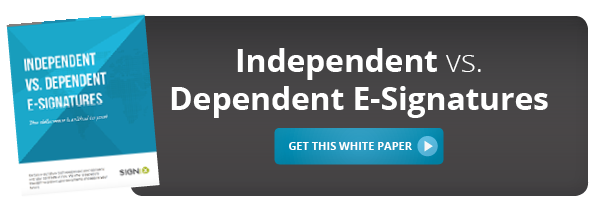SIGNiX’s e-signature technology is the obvious focal point of our business. Secure, trustworthy Independent E-Signatures™ are why we exist. But what makes our company truly unique is the people behind it all—the developers, the leaders, the support staff, everyone.
So I sat down for a chat with our fearless leader of 14 years, Jay Jumper, to pick his brain on the e-signature industry and SIGNiX’s vision.

CM: How did you get into the e-signature industry?
JJ: I previously worked at an independent registered investment advisory firm, where I noticed how difficult it was to get the signatures we needed in the pre-digital era when we had to print, mail and fax everything to our clients and our vendors. It was extremely inefficient. Over time, I had conversations with folks who were experts in the digital signature space, became familiar with the e-signature industry and technology, and eventually took the reigns as CEO of SIGNiX because I saw the tremendous potential here.
CM: According to Forrester Research, electronic signature use has grown at an average annual rate of 53% since 2012. The market clearly is expanding. Why is this happening, do you think?
JJ: When it comes to how companies today are executing businesses processes, we’re moving in one direction—and that’s digital. The convenience, efficiency and cost-savings that come with technology advances have created an irreversible domino effect. People today expect technology to make their lives easier. So now, paper-based transactions are beginning to feel arcane. Why wait for someone to fax or mail a document—or take an entire lunch hour to visit an office—to sign something that can easily be done electronically today? E-signatures are a natural part of global digitization, so I wouldn’t be surprised if the annual growth rate rises significantly in the coming few years.
CM: From your perspective, what sets SIGNiX apart in this emerging e-signature market?
JJ: SIGNiX’s e-signatures are true digital signatures. This distinction is one of the foremost reasons that SIGNiX stands apart in the market and why so many enterprises and companies in highly regulated industries feel comfortable using our technology.
A lot of people don’t realize there is a difference between an electronic signature and a digital signature. With basic electronic signatures, you don’t sign the document itself. Instead, you’re signing what’s basically an overlay on a digital document that’s uploaded from a computer. So you’re forced to trust that the e-signature vendor will maintain the signed overlay and be able to verify its association with the “signed” document.
Digital signatures, on the other hand, are a type of electronic signature that use public key infrastructure to insert a digital certificate into each signature field in the document itself. So, the legal evidence that proves a signature is valid is permanently embedded into the digital document—you’re never relying on a vendor to access that information. Like ink on paper, a digital signature is always part of a digital document.
I like to explain the difference using a Mont Blanc pen. They’re some of the best writing instruments available, but even if you signed multi-million dollar contracts with one, you probably never worried about whether or not that pen was around and working when it was time to collect your payment. With basic electronic signatures, it’s different. You have to know that your vendor will always be able to deliver your legal evidence, and you’re relying on them for it. It’s like contacting the Mont Blanc company to verify your signed transaction. With digital signatures, like SIGNiX’s Independent E-Signatures™, this is not an issue. You have complete ownership and control over that evidence forever.
CM: What challenges does the e-signature market face today?
JJ: Pertaining to e-signatures, there are two main challenges that businesses are facing today.
One—businesses have to make sure that the e-signature technology they use is compliant with industry regulations. Compliance is another area where SIGNiX stands out. Our Independent E-Signature™ technology is based on international, published standards for encryption, digital certificates, document storage and more. Because we build our technology around security and legal defensibility, we’re also compliant with HIPAA, 21 CFR Part 11, the IRS, ESIGN, UETA, eIDAS and many other industry and government requirements for e-signatures.
Two—in order for many companies to use e-signatures in meaningful ways, they need other companies and entities to accept e-signed documents in the same way that they accept physically signed documents. For instance, if a secondary mortgage firm doesn’t accept e-signatures, there’s little incentive for a lender to use them. The good news is that we’re starting to see e-signature acceptance grow across the industry spectrum.
CM: You’ve been CEO for SIGNiX for 14 years—what has your journey with the company taught you along the way?
JJ: The importance of stability and steadiness—no question.
SIGNiX was founded in 2002 when e-signatures were still a very novel concept. While most of the market rushed to find ways to upload and sign any document under the sun, we took a step back to consider where we saw e-signatures would be most important over the long-term, and that was easing the paper-burden found in high transaction volume businesses in highly regulated industries, like financial services, government, healthcare, insurance and life sciences.
So, while others rushed toward quick adoption of simple e-signatures, we built our technology to focus on security and legal defensibility first. As the market has shifted toward highly regulated industries, as we expected it would, other vendors scrambled (and are still scrambling) to retrofit their technology with improved security and defensibility. (Ask any developer and they’ll tell you that’s not an easy job.) SIGNiX, on the other hand, has a trusted foundation firmly in place and can continuously build on that foundation to easily tailor our technology to any business or industry.
Knowing where you’re going from the start, understanding how to make minor adjustments along the way, and having a tenured, trusted team to get you there are three keystones I would advocate for any business owner.
CM: Thanks so much, Jay. Before we end, any fun facts to share with our readers?
JJ: During my younger years, I was a college football referee. That might be why I thrive on intensity and honesty. Both are important parts of the game—and business.
I think it runs in the family, too. Both of my sons play football for the University of Tennessee Volunteers, and my daughter ran cross country for the Vanderbilt Commodores and won nine state titles. (Or maybe that’s just me being a proud parent, as you know, my kids are my hobby).
To learn more about the difference between an electronic signature and a digital signature, download our free white paper on e-signature independence.
%20formatted-1.png?width=2528&height=739&name=SIGNiX%20Logo%20Main%20(white)%20formatted-1.png)

